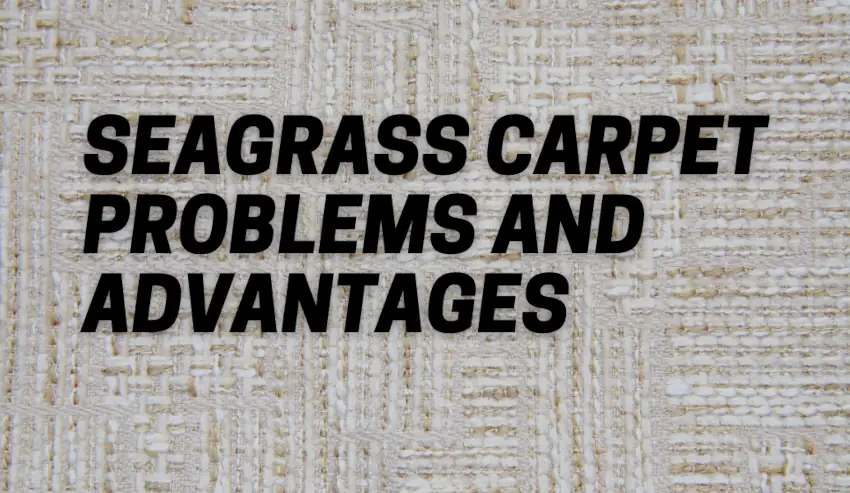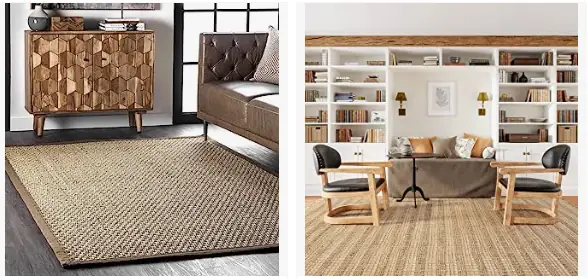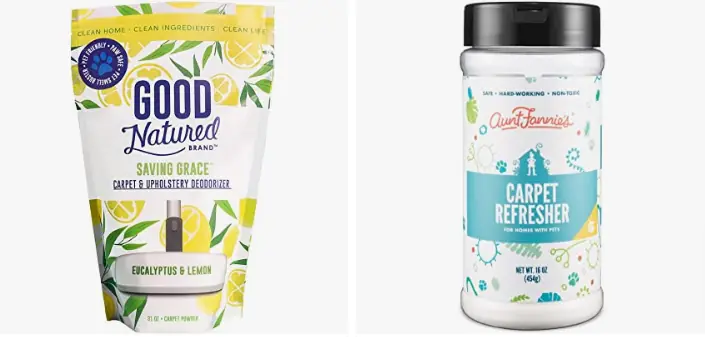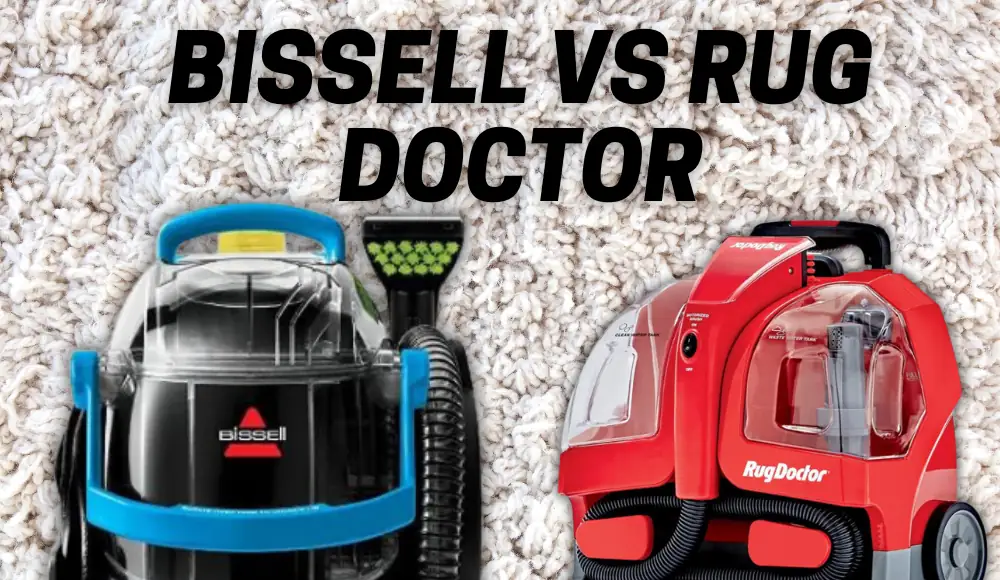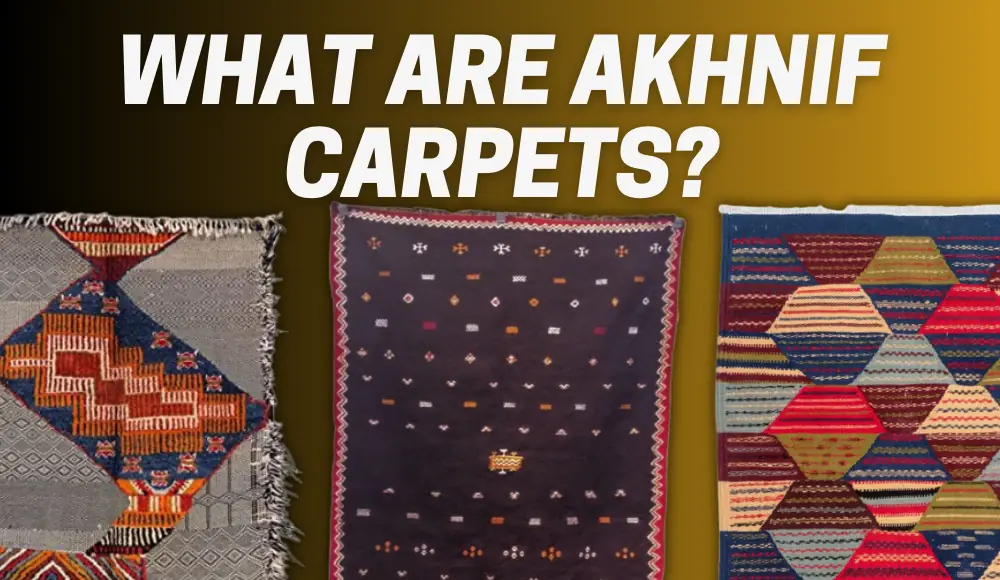Seagrass carpet is a unique flooring option that offers both natural beauty and environmental benefits. Made from the seagrass plant, it brings a touch of nature into our homes. In this article, we’ll delve into the world of seagrass carpets, exploring the seagrass carpet problems and benefits, its purpose, advantages, and potential downsides.
So, let’s dive in!
What are Seagrass Carpets For?
Seagrass carpets serve as an excellent choice for homeowners seeking a natural and eco-friendly flooring solution.
These carpets are primarily used to create a warm and inviting atmosphere in living spaces. With their distinctive texture and organic appearance, seagrass carpets add a touch of rustic charm and elegance to any room.
Moreover, seagrass carpets are highly durable, making them suitable for high-traffic areas such as living rooms, hallways, and even commercial spaces. They provide a comfortable surface for walking and lounging, making them a popular choice for families and businesses alike.

What is the Downside of Seagrass?
While seagrass carpets offer numerous advantages, it’s important to be aware of their potential downsides. One of the primary concerns with seagrass carpets is their sensitivity to moisture.
Since seagrass is a natural material, it can absorb water easily. This can lead to discoloration, warping, and even mold growth if the carpet gets wet and is not dried promptly.
Additionally, seagrass carpets may not be the best option for those seeking a plush and soft surface.
Due to their inherent texture, seagrass carpets tend to be more on the rough side. While this may not bother everyone, those with sensitive feet or a preference for a cushioned feel might find it less comfortable.
What Happens if a Seagrass Rug Gets Wet?
As mentioned earlier, seagrass carpets can be prone to damage if they get wet. When exposed to moisture, seagrass absorbs it, which can cause the fibers to expand, leading to warping and discoloration.
Additionally, prolonged exposure to moisture can create an ideal environment for mold growth.
To mitigate these risks, it’s crucial to address any spills or water damage promptly.
Blotting the affected area with a clean, absorbent cloth and allowing it to dry naturally is essential. It’s important to avoid using excessive water or harsh cleaning agents, as they can exacerbate the damage.
Is Seagrass Carpet Hard to Clean?
Seagrass carpet cleaning requires a bit of extra care when it comes to cleaning. Due to their natural fibers, they are susceptible to staining and discoloration if not handled properly.
Regular vacuuming is necessary to remove loose dirt and debris, preventing them from settling into the carpet.
In the case of spills or stains, it’s best to act quickly. Blotting the affected area with a clean, damp cloth can help lift the stain.
However, it’s important to avoid rubbing or scrubbing, as this can cause the stain to spread or damage the carpet fibers. For tougher stains, professional cleaning may be required.
Does Seagrass Mold Easily?
Seagrass carpets have a tendency to develop mold if they are exposed to excessive moisture and are not dried properly.
Mold thrives in damp environments, and seagrass, being a natural material, can provide a suitable breeding ground. To prevent mold growth, it’s essential to address any water damage promptly and ensure proper ventilation in the room.
Does Seagrass Carpet Need Underlay?
Seagrass carpets generally do not require underlay, as they are firm and durable on their own.
However, some homeowners prefer to use a thin underlay for added cushioning and insulation. It’s important to choose an underlay specifically designed for natural fiber carpets to ensure compatibility and avoid potential issues.
Are Seagrass Rugs Scratchy?
Seagrass carpets, by nature, have a rougher texture compared to other carpet materials.
While some people enjoy the tactile feel, others may find it slightly scratchy or coarse. It’s always a good idea to test the texture before making a purchase to ensure it aligns with your comfort preferences.
Does Seagrass Carpet Smell?
Seagrass carpets can have a distinct natural odor, especially when they are new. This scent is temporary and tends to dissipate over time as the carpet acclimates to its environment.
Good ventilation and regular airing of the room can help speed up this process.
Do Seagrass Rugs Hold Up?
Seagrass carpets are known for their durability and resilience. They can withstand heavy foot traffic without showing significant wear and tear. However, like any flooring material, they will eventually show signs of use over time. Regular maintenance and proper care can extend their lifespan and keep them looking their best.
Does Seagrass Carpet Shrink?
Seagrass carpets are generally not prone to shrinking. However, if exposed to excessive moisture or humidity, they can expand and contract, which may lead to slight changes in their dimensions. It’s crucial to maintain a consistent indoor environment to minimize the risk of such changes.
Is Seagrass Carpet Waterproof?
While seagrass carpets have natural water-resistant properties, they are not completely waterproof. Small spills and splashes can typically be wiped away without causing significant damage. However, prolonged exposure to water or high humidity levels can lead to potential issues, such as warping, discoloration, or mold growth.
Is Seagrass Carpet Slippery?
Seagrass carpets tend to have a natural grip due to their textured surface, making them relatively slip-resistant. However, it’s still important to exercise caution, especially if the carpet is wet or in high-traffic areas. Using non-slip rug pads or mats can provide an extra layer of safety and stability.
Are Seagrass Rugs Expensive?
Seagrass carpets are generally considered to be a cost-effective flooring option. While prices may vary depending on factors such as size, quality, and source, seagrass carpets often offer an affordable alternative to other natural fiber rugs. They provide excellent value for their durability and unique aesthetic appeal.
Where to Buy Seagrass Carpet
Seagrass carpets can be found in various home decor and flooring stores. Additionally, many online retailers offer a wide range of options to choose from. When purchasing seagrass carpet, it’s essential to ensure you are buying from a reputable source to guarantee quality and authenticity.
Is Seagrass Carpet Good for Pets?
Seagrass carpets can be a suitable choice for pet owners. Their natural durability and resistance to stains make them more forgiving in the face of pet accidents and scratches. However, it’s important to remember that seagrass carpets, like any flooring material, require regular maintenance and cleaning to keep them in good condition.
Best Seagrass Carpet
Determining the best seagrass carpet depends on individual preferences and requirements. Factors such as carpet thickness, weave, and backing should be considered. It’s advisable to explore different options, read customer reviews, and seek professional advice to find the seagrass carpet that best suits your needs.
Staining and Discoloration
Seagrass carpets are known for their natural beauty and durability. However, if not properly maintained, they can easily become stained or discolored.
The most common stains found on seagrass carpets include coffee, wine, pet urine, and food spills.
These substances can easily penetrate the fibers of your carpet and cause permanent discoloration.
In addition to staining, UV rays from direct sunlight can also cause your seagrass carpet to fade over time. To prevent stains and discoloration from occurring on your seagrass carpet, it is important to take immediate action after spills occur.
Use a clean cloth or paper towel to blot the spill immediately before it has a chance to set in. Do not rub the stain as this will only push it deeper into the fibers of your carpet making it harder to remove.
Avoid using harsh chemicals or detergents on seagrass carpets as these can cause further damage to the fibers.
If stains do occur on your seagrass carpet, there are several cleaning methods you can use depending on the severity of the stain.
For light stains, sprinkle baking soda over the affected area and allow it to sit for a few minutes before vacuuming it up with a handheld vacuum cleaner.
For more stubborn stains such as pet urine or red wine, try using vinegar mixed with water at a ratio of 1:1 applied with a clean cloth before rinsing with cold water and allowing it to air dry thoroughly
Water Damage
Seagrass carpets are a popular choice for those who desire a natural, eco-friendly floor covering.
However, seagrass is also very susceptible to water damage. Any exposure to water can cause the fibers to swell and weaken, eventually leading to the development of mold and mildew.
This can cause unsightly stains and unpleasant odors that are difficult to remove. To prevent water damage, it is important to avoid exposing your seagrass carpet to excessive moisture or standing water.

If you live in an area with high humidity, consider using a dehumidifier in the rooms with seagrass carpeting. Additionally, make sure any spills or accidents are quickly cleaned up with a dry towel or cloth.
Tips for Preventing Water Damage
- Avoid placing potted plants directly on your seagrass carpeting as they can trap moisture underneath and create a humid environment.
- Use rugs or mats in areas where spills or moisture may occur such as near entryways or in kitchens.
- Consider investing in a waterproof rug pad designed specifically for use with natural fiber carpets like seagrass.
Suggestions for Repairing Water Damage
If your seagrass carpet has already suffered from water damage, there are steps you can take to repair the affected areas.
- First, identify the extent of the damage by examining both the surface fibers and underneath the padding.
- Use a wet/dry vacuum cleaner to remove any excess moisture from the affected area.
- Allow ample time for the area to dry completely before attempting any repairs.
- If mold or mildew has developed, clean it with a solution of equal parts white vinegar and warm water before allowing it to dry completely again.
- For severe cases of water damage, it may be necessary to replace damaged sections of the carpet entirely.
Wear and Tear: The Natural Enemy of Seagrass Carpets
Seagrass carpets are made from natural fibers, which can make them more susceptible to wear and tear than synthetic carpets.
Over time, foot traffic can cause the fibers to become matted and flattened, which can make the carpet look worn and dingy.
Additionally, seagrass is more prone to fading than other types of carpeting, which means that areas that receive direct sunlight may begin to lose their color over time.
To prevent wear and tear from setting in too quickly, it’s important to take a few proactive steps.
First, consider placing area rugs or runners in high-traffic areas of your home to help distribute foot traffic more evenly across the room.
Another solution is to invest in furniture leg pads or glides that can easily slide across the seagrass carpet without causing damage.
If your seagrass carpet has already begun to show signs of wear and tear, don’t worry!
There are plenty of ways you can repair any damage that has been done. One simple solution is to use a soft-bristled brush or broom to gently fluff up matted fibers.
Another option is to use a handheld vacuum with a beater bar attachment to lift up dirt and debris from heavily trafficked areas.
For larger areas that have suffered damage, you may want to consider hiring a professional carpet cleaning service for deep cleaning or repairing any frayed edges or holes in the seagrass fibers.
Pro Tip:
To extend the life of your seagrass carpet even further, consider rotating furniture periodically throughout the room. This helps prevent uneven wear patterns from forming on your carpet over time!
Odors
The Cause of Odors in Seagrass Carpets
One of the most common complaints about seagrass carpets is unpleasant smells that develop over time. These odors are usually caused by mold and mildew growth in areas that have become damp or wet.
Organic matter that gets trapped within the fibers can also cause odors to develop, particularly if not properly cleaned.
While some odors may be mild and barely noticeable, others can be potent and even overpowering, especially in smaller spaces like bedrooms or bathrooms.
Preventing Odor Development
Fortunately, there are several steps you can take to prevent odors from developing in your seagrass carpet.
The first is to ensure proper ventilation throughout your home or office space. Allowing fresh air to circulate regularly will help prevent moisture buildup and reduce the risk of mold and mildew growth.
Another important step is regular cleaning using a vacuum cleaner with a HEPA filter to remove dirt, debris, and organic matter from deep within the fibers of your carpet. It’s also essential to avoid spills and moisture buildup whenever possible because allowing water to soak into your seagrass carpet will provide the ideal conditions for mold spores to grow and spread rapidly throughout the fibers.
Eliminating Unpleasant Odors
While generally easy to care for with the preventative measures listed above, once an odor has developed it can be difficult to eliminate completely.
One method for removing unpleasant smells from seagrass carpets is baking soda application after vacuuming as it has natural odor-absorbing properties.
Sprinkling a generous amount of baking soda on your carpet and then letting it sit for 30 minutes before thoroughly vacuuming up will help absorb any lingering smells. If baking soda doesn’t work effectively enough some professional cleaners use specialized equipment designed specifically for cleaning seagrass carpets without causing damage.
Keep in mind that once it develops, the odor can be quite stubborn and removal may require professional intervention.
The best solution is to address the underlying cause of any odors as soon as possible to prevent them from developing in the first place.
Deodorizer for natural carpets as jute rug cleaner
Conclusion
Seagrass carpets offer a unique blend of natural beauty, durability, and environmental benefits. While they have some downsides, such as sensitivity to moisture and a rough texture, these can be managed with proper care and maintenance.
Seagrass carpets provide an excellent flooring choice for those seeking a sustainable and distinctive look for their homes.
FAQs
What is the biggest threat to seagrass?
The biggest threat to seagrass is habitat destruction, primarily caused by human activities such as coastal development, pollution, and boat anchoring. Climate change and rising sea levels also pose significant challenges to seagrass ecosystems.
What is the best natural fiber carpet?
Sisal and seagrass are two popular natural fiber options for carpets. While both have their unique characteristics, the choice between them depends on personal preferences and the specific requirements of the space.
Which is better, sisal, or seagrass rugs?
The choice between sisal and seagrass rugs depends on several factors. Sisal rugs are known for their softer texture and more intricate weaves, making them suitable for spaces where comfort is a priority.
Seagrass rugs, on the other hand, offer excellent durability and are more resistant to stains and moisture.
